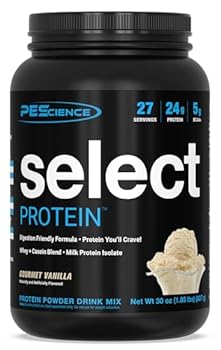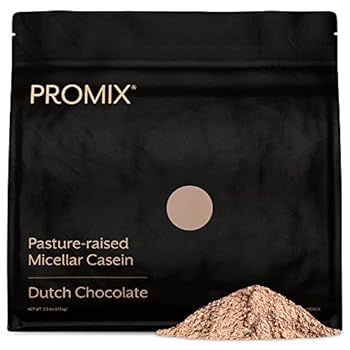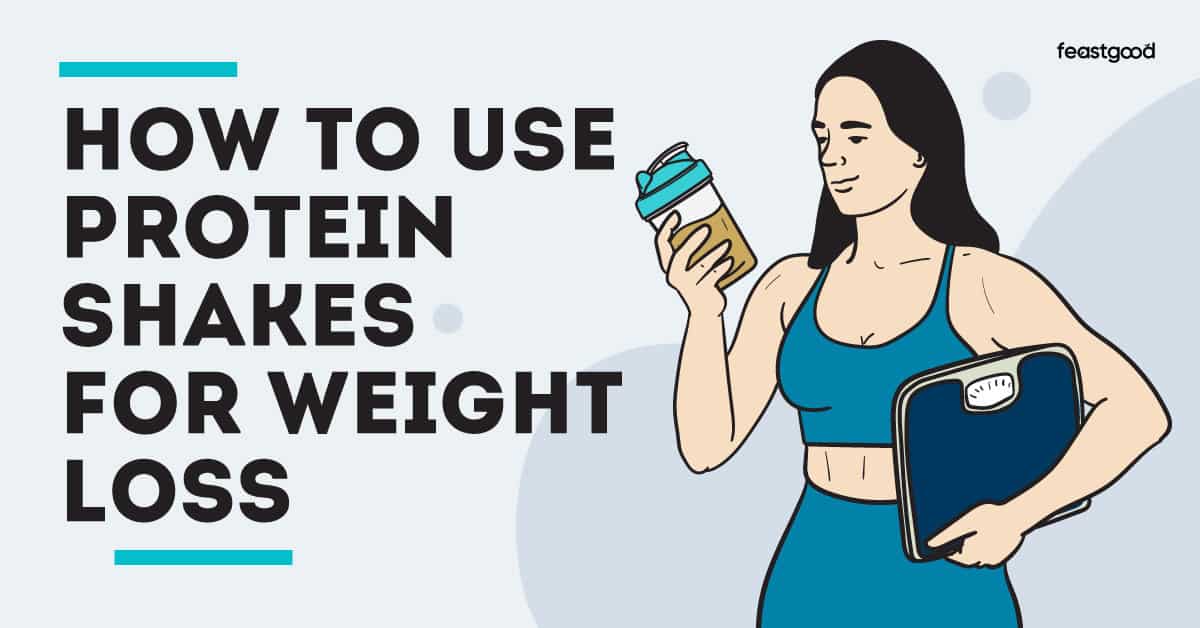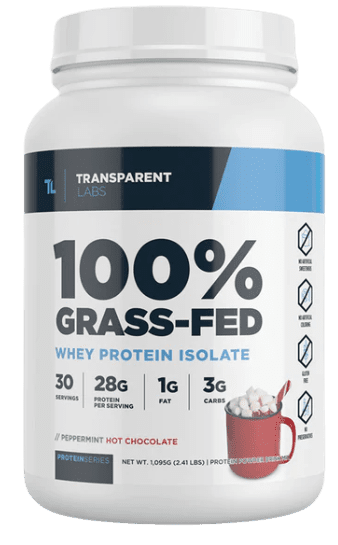Some links in this article are affiliate links, which means we earn from qualifying purchases. Learn more.
As a nutrition coach who works with clients pursuing weight loss, I’m often asked if protein shakes are a good option and how to use them to enhance weight loss.
So, how can you use protein shakes for weight loss? Protein shakes can be used to help you lose weight by increasing feelings of fullness and managing hunger. They also help to preserve your lean muscle mass, which is very important for keeping your metabolism as high as possible while losing weight.
To get the most out of your protein shakes while dieting, it’s important to know which types of protein to take, when to take it, and how much you should have.
Key Takeaways
- Strategically consuming protein shakes at certain times of the day can maximize weight loss by increasing fat loss while reducing muscle loss.
- Certain types of whey protein powder are better at different times of day.
- Limiting your protein intake from protein powders to ⅓ of your total daily intake is important for satiety and your overall health.
Does The Timing Of Protein Shakes Matter For Weight Loss?
The most important element for weight loss is ensuring you’re in a consistent calorie deficit, regardless of when calories (or protein) are consumed. However, studies show that the timing of protein ingestion can be helpful for getting people to achieve a calorie deficit.
Although calories are the most important factor when weight loss is the goal, the timing of these calories and the number of calories coming from protein can be tweaked to make weight loss easier.
Studies show that even if total daily calories and macronutrients are the same when more of those calories are consumed at breakfast instead of dinner, people lose more weight and inches.
Additionally, studies show that a high-protein breakfast leads to lower calorie intakes later in the day because it is more filling, which causes you to snack less throughout the day than if you had a lower-protein breakfast.
Therefore it’s clear that you can use protein shakes at specific times to increase satiety and reduce the urge to snack, making weight loss easier.
When Should You Drink A Shake For Weight Loss? (3 Examples)
The three best times to drink a protein shake for weight loss are in the morning, after a workout, and in the evening before bed.
In The Morning
A high-protein breakfast is very helpful for weight loss and can lead to losing even more weight and body fat; however, most people eat the majority of their protein during lunch and dinner, with breakfast being a meal that is low in protein.
This is because many traditional breakfast foods in North America are higher in carbohydrates and lower in protein, like fruit, cereal, oatmeal, toast, muffins, donuts, and pastries.
Adding a protein shake at breakfast is a great way to bump up the protein content of this meal to make it more filling, avoiding the blood sugar spike and crash that can leave you starving by mid-morning.
My favorite option is to pour a ready-to-drink protein shake on my cereal when I don’t have time to make a more elaborate protein smoothie.
- Related Article: Can You Use Whey Protein As A Meal Replacement?
Post Workout
After a workout is another great time to have a protein shake because your muscles will need amino acids from protein to repair the muscle damage that occurred while working out.
Consuming enough protein post-workout while you’re trying to lose weight can also encourage muscle retention and possibly muscle growth (if you’re new to strength training).
Preserving lean muscle mass is a priority when you want to lose weight because the more muscle you have, the more calories you burn. The more calories you burn, the easier it will be to lose weight.
Before Bed
Another great time to consume a protein shake when you want to lose weight is before bed, because studies have shown that consuming protein before bed improves overnight muscle protein synthesis (muscle building) rates and enhances recovery.
Additionally, having a source of protein before bed can help increase your quality of sleep. If you’re waking up throughout the night because you’re hungry, then it will negatively impact your sleep.
Getting better quality sleep is crucial for keeping your hunger hormones under control the following day. If you don’t sleep well, you’ll find yourself much hungrier the next day, which can cause you to consume far more calories than you typically would.
Related Article: Whey Protein Before Bed: Should You Do It?
Does The Type Of Protein Matter?
The type of protein does matter; however, it doesn’t matter as much as your total daily protein intake. Your total daily protein intake influences your ability to retain muscle, whereas the type of protein impacts your satiety.
Different types of protein digest at different rates so different types of protein are better in certain situations.
The protein types and their rates of digestion from fastest to slowest are:
- Hydrolyzed whey protein (15g/hour)
- Whey protein isolate (10g/hour)
- Whey protein concentrate (8g/hour)
- Casein protein (4-5g/hour)
Hydrolyzed whey and whey isolate are great fast-digesting choices for a protein shake post-workout, when it’s important to get nutrients into the muscles quickly.
Casein protein is a perfect choice for a pre-bedtime snack because it will digest slowly and release amino acids for several hours to support muscle building and recovery. It can also help you to get a good night’s sleep rather than waking up hungry.
At breakfast, I recommend a whey-casein blend to get the best of both worlds. Whey protein is actually linked to higher satiety compared to casein because of its high leucine content (one of the branched-chain amino acids), and the slow-digesting nature of casein will provide a steady stream of energy.
These two effects will make it less likely that you will be searching for a mid-morning snack to get you through to lunchtime, and you’ll likely be less hungry at lunchtime as well.
To summarize:
- Choose a whey-casein blend for your protein shake at breakfast – I recommend PEScience Select Low Carb Protein Powder

- Opt for a hydrolyzed whey or pure whey isolate for your post-workout shake – I recommend Transparent Labs 100% Grass-Fed Whey Protein Isolate
- Select casein protein powder for a pre-bedtime protein shake – I recommend Promix Casein Protein Powder

Does The Amount Of Protein Matter?
The amount of protein you consume does matter because it’s important to consume enough protein to retain muscle mass and improve satiety. Additionally, you should limit your consumption of protein powder to ⅓ of your total protein intake.
When you’re pursuing weight loss, I recommend a protein target of 1.2g of protein per pound of goal body weight.
For example, a person who weighs 200lbs with a goal weight of 160lbs would need to eat 192g of protein (160 x 1.2) per day, with no more than 64g (⅓ of 192) of protein coming from protein powder.
With an average of 25g of protein per scoop, this individual could have up to ~2.5 scoops of protein per day. This might mean 1 scoop at breakfast time, 1 scoop post-workout, and half a scoop before bed.
The rest of your daily protein intake should come from whole food sources like chicken and greek yogurt which have more nutrients that your body needs to function optimally.
- Check Out Whey Protein Dosage Calculator
Does The Number Of Protein Shakes Per Day Matter For Weight Loss?
Yes, the number of protein shakes per day does matter for weight loss. Too many shakes can lead to micronutrient deficiencies, which can drive increased appetite, and drinking calories can be less filling than chewing whole food, making it harder to control cravings that can come with being in a calorie deficit.
So, while having a lot of protein shakes won’t necessarily halt your weight loss as long as you are in a calorie deficit, relying on protein shakes for most of your protein intake can make weight loss harder than it needs to be.
Compared to whole food sources of lean protein, protein powders tend to have fewer micronutrients (vitamins and minerals that are naturally occurring in whole food sources), so an overreliance on protein shakes can cause you to miss out on these key micronutrients.
Some micronutrient deficiencies directly impact your metabolism. For example, a low iodine level can reduce thyroid function.
Beyond that, your appetite may increase when you are missing micronutrients as your body’s way of trying to get you to eat the foods that contain the missing micronutrients.
Next, it’s usually faster and easier to drink a protein shake than it is to eat a meal with the same amount of calories and protein when you have to chew and swallow your food. Chewing and swallowing your food helps to signal to your body to reduce appetite.
For these reasons, I recommend no more than 1-2 protein shakes per day for weight loss, keeping with my earlier recommendation to limit protein intake from protein powder to no more than ⅓.
Getting at least ⅔ of your daily protein intake from whole foods will make your weight loss journey easier, for the reasons stated above.
- Related Article: How Long Does It Take Whey Protein Powder To Show Results?
Practical Recommendations

With so many numbers and recommendations for different types of protein and different times of day, it can feel overwhelming and easier to give up. I’ve come up with four easy steps to follow to help you implement these changes over time, rather than all at once.
Taking it step-by-step will make it easier to incorporate protein shakes into your weight loss routine.
1. Focus On Total Protein Intake First
Consuming enough protein is the most important step (besides hitting your calorie target) when it comes to weight loss. Start by tracking your current intake with a macro-tracking app like MacroFactor.
If you’re consistently consuming around 1.2g per pound of goal body weight then you’re doing great, and you can move on to the next steps.
If you’re not consuming anywhere near this recommendation, then make it a goal to gradually increase your protein intake closer to this target.
For example, if your current intake is 50 grams of protein per day and your goal intake is 150 grams per day, it doesn’t make sense to try to triple your intake all at once.
Focus on gradually increasing your serving sizes of whole food protein sources (i.e. 5 oz instead of 3 oz), adding more high-protein snacks (i.e. greek yogurt), swapping out carbs for higher protein carbs (i.e. protein pasta rather than regular pasta), or adding more supplements (i.e. protein shakes, protein bars).
Once you can consistently hit your protein target, it’s time to move to the next step.
2. Keep Protein Intake From Protein Powders To 1/3 Of Total Intake
Once you can consistently hit your total protein target, it’s time to focus on making sure that at least two-thirds of your daily protein intake is coming from whole food sources of protein like yogurt, eggs or egg whites, fish, chicken, or red meat.
If you’re struggling to get more protein from whole foods instead of protein powders, check out Whey Protein Foods: 10 Foods Naturally Rich In Whey Protein.
3. Find Brands Of Protein Powders You Like
If you’re planning to include protein shakes every day to help with your weight loss goals, then it’s going to be important for you to find protein powders that you like and that have higher-quality ingredients.
You’re going to want to try different brands and flavors – I suggest getting some sample-size packages before committing to an entire tub in case you find out that you don’t like the taste, or the protein causes you digestive discomfort like nausea, constipation, or diarrhea.
Look for brands of protein powders that have higher percentages of protein per serving (75% or more) to ensure the product isn’t full of cheap fillers, and prioritize brands that are third-party tested for label accuracy and ingredient purity.
As a resource to help you navigate the hundreds of protein powders available online, I wrote: Best Low-Calorie Protein Powders For Weight Loss
4. Optimize The Type Of Protein Powder To Certain Times Of Day
The final step in the process, once you are in the groove of hitting your protein targets, you’ve found a brand of protein you enjoy and trust, and you’re drinking protein shakes consistently, is to explore different types of protein powder for different times of the day.
Remember that my recommendations were for a whey+casein blend at breakfast, whey hydrolysate or isolate for post-workout, and casein protein powder before bed.
- Related Article: How Much Protein When Cutting? (A Nutrition Coach Answers)
Frequently Asked Questions
Is It Better To Drink A Protein Shake Before Or After A Workout For Weight Loss?
It is better to drink a protein shake after a workout for weight loss because it will repair muscle damage and preserve muscle mass, which will help you continue burning calories at a faster rate. It will also help curb your cravings, leading to better choices and reduced snacking.
Is It Better To Drink A Protein Shake In The Morning Or At Night For Weight Loss?
It is better to drink a protein shake in the morning for weight loss. High protein intake in the morning will reduce calorie intake later in the day, and leads to more weight loss than increased protein intake at night.
References
Jakubowicz, D., Barnea, M., Wainstein, J., & Froy, O. (2013). High caloric intake at breakfast vs. dinner differentially influences weight loss of overweight and obese women. Obesity, 21(12), 2504-2512. https://doi.org/10.1002/oby.20460.
Thomas M Longland and others, Higher compared with lower dietary protein during an energy deficit combined with intense exercise promotes greater lean mass gain and fat mass loss: a randomized trial, The American Journal of Clinical Nutrition, Volume 103, Issue 3, March 2016, Pages 738–746, https://doi.org/10.3945/ajcn.115.119339
Schmid SM, Hallschmid M, Jauch-Chara K, Born J, Schultes B. A single night of sleep deprivation increases ghrelin levels and feelings of hunger in normal-weight healthy men. J Sleep Res. 2008 Sep;17(3):331-4. doi: 10.1111/j.1365-2869.2008.00662.x. Epub 2008 Jun 28. PMID: 18564298.
Thomson, C.A., Morrow, K.L., Flatt, S.W., Wertheim, B.C., Perfect, M.M., Ravia, J.J., Sherwood, N.E., Karanja, N., & Rock, C.L. (2012). Relationship Between Sleep Quality and Quantity and Weight Loss in Women Participating in a Weight-Loss Intervention Trial. Obesity, 20(7), 1419-1425. https://doi.org/10.1038/oby.2012.62.
Slyper A. (2021). Oral Processing, Satiation and Obesity: Overview and Hypotheses. Diabetes, metabolic syndrome and obesity : targets and therapy, 14, 3399–3415. https://doi.org/10.2147/DMSO.S314379
About The Author

Lauren Graham is a Precision Nutrition Level 1 certified nutrition coach. She focuses on helping busy professionals balance healthy eating and purposeful movement. Lauren has a background in competitive swimming and is currently competing as a CrossFit athlete. She has a passion for training, teaching, and writing.
Why Trust Our Content

On Staff at FeastGood.com, we have Registered Dietitians, coaches with PhDs in Human Nutrition, and internationally ranked athletes who contribute to our editorial process. This includes research, writing, editing, fact-checking, and product testing/reviews. At a bare minimum, all authors must be certified nutrition coaches by either the National Academy of Sports Medicine, International Sport Sciences Association, or Precision Nutrition. Learn more about our team here.
Have a Question?
If you have any questions or feedback about what you’ve read, you can reach out to us at [email protected]. We respond to every email within 1 business day.


